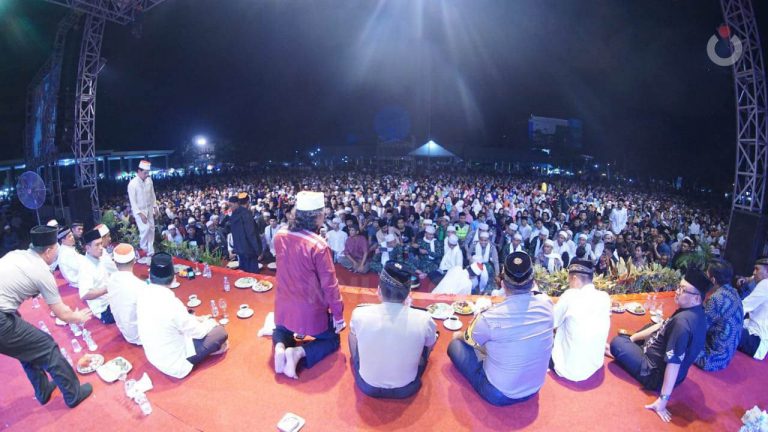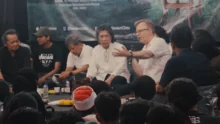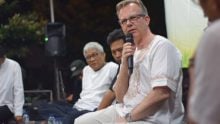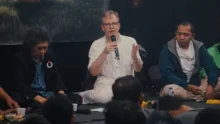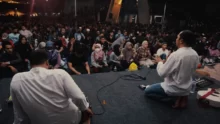“Spiritual Capital”: Kenduri Cinta at 23 Years

This week we celebrate 23 years since Kenduri Cinta was first initiated at Taman Ismail Marzuki in Cikini, Jakarta, in 2000. A year later in 2001 Mbah Nun and Kiai Kanjeng staged a major concert, “Konser Kenduri Cinta”, at Senayan. The performance featured some of their most important devotional songs, Thibil Qulub, Hubbu Ahmadin, Wirid Padhangmbulan, Tombo Ati and many others, loud and powerful. The event marked something of a closure. It was a consolidation of those frantic few years between 1997 and 2000 spent in building, supporting and reconstructing the political, social and cultural fabric of Indonesia both in readiness for and in response to, reformasi.
This culminated in the stepping down of President Suharto in May, 1998 and Mbah Nun had played a pivotal role throughout.
The inauguration of Kenduri Cinta followed the earlier Padhangmbulan mBulan gathering that had been established several years before in Jombang and marked the end of one phase of activism and the beginning of another. The overt political activism that defined Mbah Nun’s work during the 1990s gave way to another kind of activism and the beginning of the cultural reconstruction we know as Maiyah. It is this exploration and setting of values that we celebrate this week, 23 years after Kenduri Cinta first started.
Kenduri Cinta is less an “event” and more a platform for guests and contributors to open dialogue and engage with the jamaah, equally, and with no barriers. There are some constants — Mbah Nun is one, perhaps the principal one, but even he is not present at every gathering — Syeich Nursamad Kamba was another regular contributor and there have been many more over these 23 years, all teaching and taking part in discourse, sharing knowledge, bearing witness and bringing about “light”, joy and positivity.
Kenduri Cinta is about inclusivity and pluralism. All Maiyah gatherings are carried out within Islamic cultural norms with reverence for Allah and his prophet (pbuh). In Kenduri Cinta we learned about the life and work of the Prophet Muhammad in lessons and stories told by Mbah Nun, Toto Raharjo, Nursamad Kamba, and many others. With them we explored the Qur’an as the prophet and his earlier followers met their challenges first in Mecca, then Medina, a mission of 23 years that was punctuated by the remarkable act of the Hijrah, a series of wars, and then a period of nation-building and the settling of hearts.
All of this is relayed and discussed in gatherings where there are Muslims, Christians, Catholics, Hindus and Buddhists present — people of all faiths and some of none. Kenduri Cinta has embraced guests from many countries, cultures and faiths, and by way of Mbah Nun and KiaiKanjeng’s international tours and appearances its values have been exported and embedded in many more. Mbah Nun refined his art through writers’ residences overseas in the Netherlands and the USA and he has never forgotten those he met there. Their references and names punctuate many Maiyah gatherings. Such openness and plurality is the essence of Kenduri Cinta.

Just as Kenduri Cinta’s leaders, principals and contributors come and go, so does its jamaah community. Relatively few who attend now were present when it started 23 years ago. Most are younger and from much more recent times. This regeneration tells us that Kenduri Cinta has served to educate and graduate its “students” as they learn and grow and take their places in business, politics and society, building companies, institutions and families and sharing the lessons they learned at Kenduri Cinta. At last month’s Kenduri Cinta we talked about “capital” — whether financial, human or social. Perhaps this is Kenduri Cinta’s greatest achievement: to inculcate a set of cultural values that serve as the “spiritual capital” for a lifetime.
Mbah Nun said last month at Kenduri Cinta that he’d learned late in life that “capital” is not a “bad” thing in and of itself, that it can be accumulated and used for “good” and that it is the responsibility of the jamaah to grow and use it for the benefit of all. Perhaps the greatest “investment” of all at Kenduri Cinta has been the investment in the “spiritual” capital which has been sown, taken root and flourished in society. Written works such as “99 Untuk Tuhanku”, “Lautan Jilbab”, “Cahaya Maha Cahaya”, “Indonesia: Bagian dari Desa Saya” and tens more have had an undeniable and lasting influence on the literary and cultural fabric of Indonesia. The medium may changed as books give way to blogs, social media posts and videos, but the message remains constant: the strength of the “good”, of love and the lessons of Maiyah.
Let us hope for many more years of Kenduri Cinta.
